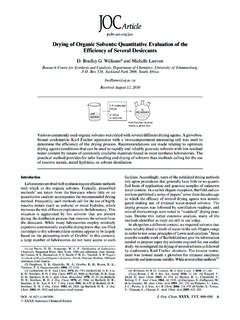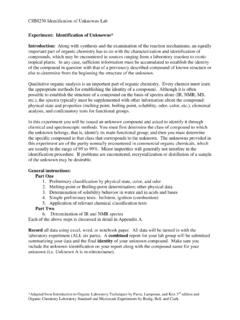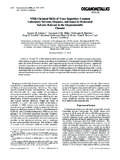Transcription of Q3C (R6) Step 5 - impurities: guideline for residual solvents
1 Temporary visiting address Spark building Orlyplein 24 1043 DP Amsterdam The Netherlands For deliveries refer to An agency of the European Union Send us a question via Telephone +31(0)88 781 6000 European Medicines Agency, 2019. Reproduction is authorised provided the source is acknowledged. 9 August 2019 EMA/CHMP/ICH/82260/2006 Committee for Human Medicinal Products ICH guideline Q3C (R6) on impurities: guideline for residual solvents Step 5 Adopted by CHMP for release for consultation 23 July 2015 Start of public consultation 4 August 2015 End of consultation (deadline for comments) 3 November 2015 Final adoption by CHMP 15 December 2016 Date for coming into effect 14 June 2017 ICH guideline Q3C (R6) on impurities: guideline for residual solvents EMA/CHMP/ICH/82260/2006 Page 2/39 Document History Code History Date Parent guideline : Impurities: guideline for residual solvents Q3C Approval by the Steering Committee under Step 2 and release for public consultation.
2 6 November 1996 Q3C Approval by the Steering Committee under Step 4 and recommendation for adoption to the three ICH regulatory bodies. 17 July 1997 Revision of the PDE information for THF contained in the Parent guideline Q3C(R1) Note: Prior to adding the revision to the parent guideline in November 2005, the code was Q3C(M) for THF. Permissible Daily Exposure (PDE) for Tetrahydrofuran (THF): revision of PDE based on new toxicological data. Approval by the Steering Committee of the new PDE for THF under Step 2 and release for public consultation. 20 July 2000 Q3C(R1) Note: Prior to adding the revision to the parent guideline in November 2005, the code was Q3C(M) for THF. Approval by the Steering Committee under Step 4 and recommendation for adoption to the three ICH regulatory bodies. 12 September 2002 ICH guideline Q3C (R6) on impurities: guideline for residual solvents EMA/CHMP/ICH/82260/2006 Page 3/39 Revision of PDE information for NMP contained in the Parent guideline Q3C(R2) Note: Prior to adding the revision to the parent guideline in November 2005, the code was Q3C(M) for NMP.
3 Permissible Daily Exposure (PDE) for N-Methylpyrrolidone (NMP): revision of PDE based on new toxicological data. Approval by the Steering Committee of the Revision under Step 2 and release for public consultation. 20 July 2000 Q3C(R2) Note: Prior to adding the revision to the parent guideline in November 2005, the code was Q3C(M) for NMP. Approval by the Steering Committee under Step 4 and recommendation for adoption to the three ICH regulatory bodies. 12 September 2002 Q3C(R3) Note: Prior to adding the corrigendum to the parent guideline in November 2005, the code was Q3C(M) for NMP. Corrigendum to calculation formula approved by the Steering Committee. 28 October 2002 Q3C(R3) The parent guideline is now renamed Q3C(R3) as the two updates (PDE for N-Methylpyrrolidone and PDE for Tetrahydrofuran) and the corrigendum of the update for NMP have been added to the parent guideline . November 2005 ICH guideline Q3C (R6) on impurities: guideline for residual solvents EMA/CHMP/ICH/82260/2006 Page 4/39 Parent guideline : Impurities: guideline for residual solvents Q3C(R4) Update of Table 2, Table 3 and Appendix 1 to reflect the revision of the PDEs for N-Methylpyrrolidone and Tetrahydrofuran.
4 February 2009 Revision of PDE information for Cumene contained in the Parent guideline Q3C(R5) Permissible Daily Exposure (PDE) for Cumene: revision of PDE based on new toxicological data. Approval by the Steering Committee under Step 2 and release for public consultation. 26 March 2010 Q3C(R5) Approval of the PDE for Cumene by the Steering Committee under Step 4 and recommendation for adoption to the three ICH regulatory bodies. The PDE for Cumene document has been integrated as part IV in the core Q3C(R4) guideline which was then renamed Q3C(R5). The Table 2, Table 3 and Appendix 1 have been updated to reflect the revision of the PDE for Cumene. 4 February 2011 Revision of PDE information for Methylisobutylketone contained in the Parent guideline and to include a PDE for Triethylamine Q3C(R6) Permissible Daily Exposure (PDE) for Triethylamine and Methylisobutylketone: revision of PDE based on new toxicological data.
5 Approval by the Assembly under Step 2 and release for public consultation. 9 November 2016 Q3C(R6) Approval of the PDE for Triethylamine and Methylisobutylketone by the Assembly under Step 4 and recommendation for adoption to the three ICH regulatory bodies. The PDE for Triethylamine and Methylisobutylketone document has been integrated as part V in the core Q3C(R5) guideline which was then renamed Q3C(R6). The Table 2, Table 3 and Appendix 1 have been updated to reflect the revision of the PDE for Triethylamine and Methylisobutylketone. 9 November 2016 ICH guideline Q3C (R6) on impurities: guideline for residual solvents EMA/CHMP/ICH/82260/2006 Page 5/39 Correction of the PDE for Ethyleneglycol Q3C(R7) Correction for the PDE and concentration limit for Ethyleneglycol on Table 2 page 6, as per the correct value calculated in Pharmeuropa, Vol. 9, No. 1, Supplement, April 1997 S36. 15 October 2018 Q3C(R6) Further to archival searches related to the Permissible Daily Exposure (PDE) for ethyleneglycol, the Q3C(R7) guideline was reverted back to the Q3C(R6) guideline .
6 Further information is provided in the cover statement dated 22 July 2019. 22 July 2019 Q3C (R6): Impurities: guideline for residual solvents EMA/CHMP/ICH/82260/2006 Page 6/39 Q3C (R6): Impurities: guideline for residual solvents Table of contents Part I .. 7 1. Introduction .. 7 2. Scope of the guideline .. 7 3. General principles .. 8 Classification of residual solvents by risk assessment .. 8 Methods for establishing exposure limits .. 8 Options for describing limits of class 2 solvents .. 8 Analytical procedures .. 10 Reporting levels of residual solvents .. 10 4. Limits of residual solvents .. 10 solvents to be avoided .. 10 solvents to be limited .. 11 solvents with low toxic potential .. 12 solvents for which no adequate toxicological data was found .. 13 Glossary .. 14 Appendix 1. List of solvents included in the guideline .. 15 Appendix 2. Additional background.
7 19 Environmental regulation of organic volatile solvents .. 19 residual solvents in pharmaceuticals .. 19 Appendix 3. Methods for establishing exposure limits .. 20 Q3C (R6): Impurities: guideline for residual solvents EMA/CHMP/ICH/82260/2006 Page 7/39 Part I 1. Introduction The objective of this guideline is to recommend acceptable amounts for residual solvents in pharmaceuticals for the safety of the patient. The guideline recommends use of less toxic solvents and describes levels considered to be toxicologically acceptable for some residual solvents . residual solvents in pharmaceuticals are defined here as organic volatile chemicals that are used or produced in the manufacture of drug substances or excipients, or in the preparation of drug products. The solvents are not completely removed by practical manufacturing techniques. Appropriate selection of the solvent for the synthesis of drug substance may enhance the yield, or determine characteristics such as crystal form, purity, and solubility.
8 Therefore, the solvent may sometimes be a critical parameter in the synthetic process. This guideline does not address solvents deliberately used as excipients nor does it address solvates. However, the content of solvents in such products should be evaluated and justified. Since there is no therapeutic benefit from residual solvents , all residual solvents should be removed to the extent possible to meet product specifications, good manufacturing practices, or other quality-based requirements. Drug products should contain no higher levels of residual solvents than can be supported by safety data. Some solvents that are known to cause unacceptable toxicities (Class 1, Table 1) should be avoided in the production of drug substances, excipients, or drug products unless their use can be strongly justified in a risk-benefit assessment. Some solvents associated with less severe toxicity (Class 2, Table 2) should be limited in order to protect patients from potential adverse effects.
9 Ideally, less toxic solvents (Class 3, Table 3) should be used where practical. The complete list of solvents included in this guideline is given in Appendix 1. The lists are not exhaustive and other solvents can be used and later added to the lists. Recommended limits of Class 1 and 2 solvents or classification of solvents may change as new safety data becomes available. Supporting safety data in a marketing application for a new drug product containing a new solvent may be based on concepts in this guideline or the concept of qualification of impurities as expressed in the guideline for drug substance (Q3A, Impurities in New Drug Substances) or drug product (Q3B, Impurities in New Drug Products), or all three guidelines. 2. Scope of the guideline residual solvents in drug substances, excipients, and in drug products are within the scope of this guideline . Therefore, testing should be performed for residual solvents when production or purification processes are known to result in the presence of such solvents .
10 It is only necessary to test for solvents that are used or produced in the manufacture or purification of drug substances, excipients, or drug product. Although manufacturers may choose to test the drug product, a cumulative method may be used to calculate the residual solvent levels in the drug product from the levels in the ingredients used to produce the drug product. If the calculation results in a level equal to or below that recommended in this guideline , no testing of the drug product for residual solvents need be considered. If, however, the calculated level is above the recommended level, the drug product should be tested to ascertain whether the formulation process has reduced the relevant solvent level to within the acceptable amount. Drug product should also be tested if a solvent is used during its manufacture. This guideline does not apply to potential new drug substances, excipients, or drug products used during the clinical research stages of development, nor does it apply to existing marketed drug products.














